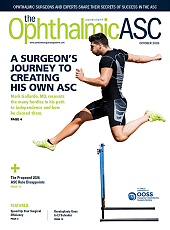Ensuring appropriate documentation for all diagnostic tests is essential for compliance, reimbursement, and patient care. The Centers for Medicare and Medicaid Services (CMS) has clear guidelines for medical necessity, appropriate ordering, and proper documentation. Diagnostic tests include lab work, imaging, and all other tests necessary for diagnosis.
A documented order is required in retina practices because the ancillary staff generally performs most of the diagnostic testing. The provider who will use the test findings must order the test, and the test must provide additional information concerning the patient’s treatment or management.
Whether you’re a physician, biller, or practice administrator, understanding the documentation requirements can help prevent claim denials and audits. Here are the answers to some common questions, using CMS policies1-4 to guide best practices.
Q. What must be included in the medical record to support the need for a diagnostic test?
A. The documentation should support the medical necessity in the chart note, which includes the patient’s history, symptoms, or conditions that justify the test. The physician’s clinical reasoning and any relevant prior treatments or findings to help support the decision to order the test are also appropriate in order to make the medical necessity clear.
Q. What must be documented when ordering a diagnostic test?
A. The order should include the medical indication, the test modality, the structure to be imaged, and the expected time frame for the testing. In ophthalmology, the order should indicate the eye to be tested, or both eyes if appropriate.
Q. What must be included in a diagnostic test’s interpretation and report (I&R)?
A. It’s not enough to list the raw data or measurements generated by the testing instrument; the test findings must be explained in an interpretation, while the report specifies how the results will affect the patient’s treatment plan. Meaningful documentation is required; writing “positive,” “normal,” or “no change” is not acceptable.
Q. Can templates or macros be used to document diagnostic test interpretations?
A. Yes, but the documentation must reflect the actual findings of each test for the individual patient. Using generic templates that do not provide meaningful interpretations or appear cloned from 1 visit to another or from patient to patient can lead to audits and denials.
Q. What happens if the documentation does not clearly support the medical necessity of a test?
A. If medical necessity is not apparent in the documentation, the claim may be denied, and reimbursement may be withheld, or if the claim was already paid, the payment may be recouped. CMS requires the medical record to support why the test was ordered, how it contributes to patient care, and that the service is medically reasonable and necessary.
Typically, the I&R is separate from the impression and plan (I&P) discussion for how the test findings impacted the patient’s treatment or management.
Q. Can a physician retroactively add documentation to support a test order?
A. No. Retrospective alterations to medical records to justify medical necessity are not allowed. Specific protocols must be followed for any late entries, corrections, or addendums. Additionally, they must be properly dated and signed.
Q. Can a physician bill for a diagnostic test if the results do not change the patient’s treatment or management?
A. Diagnostic tests are expected to contribute to patient care decisions. Proper documentation should explain why the test was performed and how the results were used. If a test result doesn’t impact management or treatment, its necessity may be questioned during an audit. RP
References
1. CMS Pub. 100-02, Medicare Benefit Policy Manual, Chapter 15, Section 80.6; Rev. 12865. October 4, 2024. Accessed April 7, 2025. https://www.cms.gov/medicare/prevention/prevntiongeninfo/downloads/bp102c15.pdf
2. Medicare Learning Network (MLN) Matters. Guidance on coding and billing date of service on professional claims (SE17023). February 1, 2019. Accessed April 7, 2025. https://www.cms.gov/Outreach-and-Education/Medicare-Learning-Network-MLN/MLNMattersArticles/downloads/SE17023.pdf
3. CMS Pub. 100-08, Program Integrity Manual, Chapter 3, Section 3.3.2.4. Revision 12772. August 9, 2024. Accessed April 7, 2025. https://www.cms.gov/Regulations-and-Guidance/Guidance/Manuals/Downloads/pim83c03.pdf
4. CMS Pub. 100-08, Program Integrity Manual, Chapter 3, Section 3.3.2.5. Revision 12772. August 9, 2024. Accessed April 7, 2025. https://www.cms.gov/Regulations-and-Guidance/Guidance/Manuals/Downloads/pim83c03.pdf









